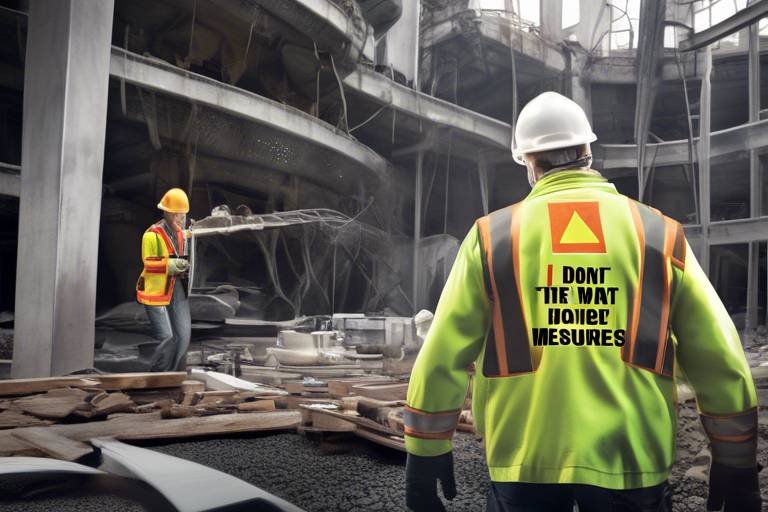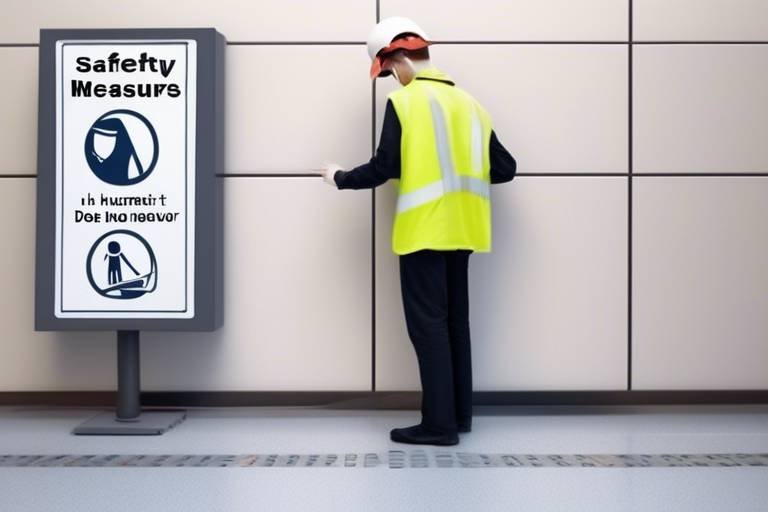From Understanding Human Behavior to Implementing Safety Measures
In today's world, where safety is paramount, understanding human behavior plays a crucial role in implementing effective safety measures. Think about it: every day, we make countless decisions that impact our safety, from the way we drive to the precautions we take at work. But what drives these decisions? This article dives deep into the intricate relationship between human psychology and safety protocols, shedding light on how recognizing psychological factors can lead to enhanced safety in various environments.
When we talk about safety, it’s not just about rules and regulations; it’s about how people perceive risks and respond to them. Have you ever wondered why some individuals take unnecessary risks while others are overly cautious? The answer often lies in our cognitive biases and emotional responses. For instance, someone might underestimate the dangers of texting while driving because they believe “it won't happen to me.” This perception is influenced by their past experiences and the information they choose to acknowledge. By understanding these psychological nuances, organizations can tailor their safety measures to resonate more effectively with individuals.
Moreover, the implementation of safety measures is not a one-size-fits-all approach. It requires a deep dive into behavioral theories that explain how people react to safety protocols. For example, the Social Learning Theory emphasizes that individuals learn behaviors by observing others. Imagine a workplace where employees actively model safe practices for their peers; this can create a ripple effect, leading to widespread adherence to safety protocols. The essence here is that safety is not just a personal responsibility but a collective one, influenced by the behaviors we observe in our environment.
As we explore this connection further, we’ll also touch upon the importance of organizational culture in shaping employee behavior. A workplace that prioritizes safety creates an environment where employees feel empowered to follow protocols and report unsafe practices without fear of reprisal. This cultural aspect is vital; it transforms safety from a mere obligation into a shared value. By fostering a culture of safety, organizations can significantly reduce risky behaviors and enhance overall compliance.
In summary, the path from understanding human behavior to implementing safety measures is paved with insights from psychology and behavioral theories. By recognizing the factors that influence risk perception and behavior, organizations can develop more effective safety protocols that resonate with individuals on a personal level. So, as we venture further into this article, let’s uncover the strategies and principles that can transform safety practices across various domains.
- Why is understanding human behavior important for safety measures?
Understanding human behavior helps tailor safety protocols to align with how people naturally think and act, leading to more effective compliance. - What role does organizational culture play in safety compliance?
A strong safety culture encourages employees to prioritize safety and fosters an environment where they feel comfortable adhering to protocols. - How can behavioral theories improve safety training?
Behavioral theories, such as Social Learning Theory, can inform training programs by emphasizing the importance of modeling safe behaviors.

The Psychology of Risk Perception
Understanding how individuals perceive risk is a fascinating and complex endeavor. It’s not just about the facts and figures; it’s about the psychological underpinnings that shape our understanding of danger. Have you ever noticed how some people seem to fear flying while others are completely unfazed? This discrepancy often stems from cognitive biases and emotional factors that influence how we assess risk in our daily lives. For instance, the availability heuristic can cause us to overestimate the likelihood of dramatic events, like plane crashes, simply because they are more memorable than mundane occurrences like car accidents. This is a prime example of how our brains can trick us into thinking we’re at greater risk than we actually are.
Moreover, emotional responses play a significant role in risk perception. When faced with a potential threat, our feelings can cloud our judgment. A person may react more strongly to a perceived danger if they have had a personal experience related to it. For example, someone who has witnessed a severe car accident may develop an intense fear of driving, even if statistically, it is one of the safest modes of transportation. This emotional bias can lead to irrational behaviors, such as avoiding certain activities altogether, which can ultimately impact their overall quality of life.
In addition to cognitive biases and emotional factors, social influences cannot be overlooked. The opinions and behaviors of those around us can significantly shape our perception of risk. If a friend expresses fear about a particular situation, it can trigger similar feelings in us, even if we initially felt safe. This phenomenon highlights the importance of understanding the social context in which risk is perceived.
To illustrate the various factors that influence risk perception, consider the following table that summarizes key elements:
| Factor | Description |
|---|---|
| Cognitive Biases | Systematic patterns of deviation from norm or rationality in judgment. |
| Emotional Responses | Feelings that can distort our perception of risk based on personal experiences. |
| Social Influences | The impact of others' opinions and behaviors on our own risk assessment. |
By recognizing these factors, we can better understand why people react differently to safety measures and protocols. It’s essential for organizations to consider these psychological elements when designing safety interventions. After all, if we want to create effective safety measures, we must first understand the human psyche that drives behavior. This understanding can lead to more effective communication strategies, improved training programs, and ultimately, a safer environment for everyone.

Behavioral Theories in Safety Practices
When it comes to safety practices, understanding the psychology behind human behavior is paramount. Behavioral theories offer a framework for interpreting how individuals respond to safety protocols and what drives their actions in various situations. These theories help us decode the complex interplay between human behavior and safety measures, allowing organizations to craft more effective strategies. By examining these theories, we can uncover insights that not only enhance compliance but also foster a culture of safety.
One of the most significant theories in this realm is the Social Learning Theory. This theory posits that people learn behaviors through observation and imitation of others. Imagine a workplace where employees witness their peers consistently adhering to safety protocols. This environment encourages them to emulate those safe behaviors, creating a ripple effect that can lead to widespread compliance. It’s like watching a well-choreographed dance; when one person moves in sync, others are likely to follow suit. This principle can be harnessed in safety training programs to model safe practices effectively.
Integrating the principles of Social Learning Theory into workplace training is not just beneficial; it’s essential. Training sessions that emphasize modeling safe behaviors can significantly enhance the effectiveness of safety protocols. For instance, consider a scenario where a supervisor demonstrates the proper use of personal protective equipment (PPE). Employees observing this demonstration are more likely to adopt the same behaviors, reinforcing a culture of safety. Moreover, incorporating peer feedback into these training sessions can further solidify these safe practices. When employees feel supported and encouraged by their peers, they are more likely to engage in safe behaviors consistently.
The culture of an organization plays a pivotal role in shaping employee behavior. A strong culture of safety can lead to a significant reduction in risky behaviors and accidents. When safety is prioritized at all levels, employees are more likely to internalize safe practices as part of their daily routines. This cultural shift can be achieved through consistent communication, recognition of safe behaviors, and a supportive environment that encourages reporting unsafe conditions without fear of retribution. In essence, fostering a culture of safety transforms safety compliance from a mere obligation into a shared value among all employees.
Behavioral economics further enriches our understanding of safety practices by examining how psychological factors influence decision-making. This field reveals that individuals often make choices based not just on rational assessments, but on cognitive biases and emotional responses. For instance, the availability heuristic might lead someone to underestimate the risk of an accident if they have not witnessed one recently. By recognizing these biases, organizations can tailor their safety messages and interventions to counteract these tendencies, encouraging more proactive safety behaviors.
In conclusion, the integration of behavioral theories into safety practices is not just a theoretical exercise; it’s a practical approach that can lead to tangible improvements in workplace safety. By understanding how individuals learn and behave, organizations can design more effective training programs, foster a culture of safety, and ultimately reduce the occurrence of accidents and injuries.
- What is Social Learning Theory?
Social Learning Theory is a psychological concept that suggests individuals learn behaviors through observing and imitating others. In a safety context, modeling safe behaviors can lead to greater compliance among employees.
- How can organizations foster a culture of safety?
Organizations can foster a culture of safety by prioritizing safety in communications, recognizing safe behaviors, and creating an environment where employees feel comfortable reporting unsafe conditions.
- What role does behavioral economics play in safety compliance?
Behavioral economics examines how psychological factors and cognitive biases influence decision-making. Understanding these can help organizations design better safety protocols that encourage proactive behaviors.

Social Learning Theory
The is a fascinating concept that underscores the power of observation and imitation in shaping human behavior. Imagine watching a friend effortlessly navigate a tricky situation and thinking, “If they can do it, so can I!” This theory posits that individuals learn not only through direct experience but also by watching others. In the context of safety practices, this means that when people see their peers adhering to safety protocols, they are more likely to follow suit. It’s like a domino effect—one safe behavior can lead to another, creating a culture of safety.
At its core, Social Learning Theory emphasizes that learning is a social process. We are influenced by the behaviors of those around us, especially in environments where safety is paramount. For instance, if employees observe their colleagues consistently wearing protective gear, they are more inclined to do the same, reinforcing the importance of safety measures. This is particularly crucial in high-risk environments, such as construction sites or manufacturing plants, where the stakes are high, and the consequences of unsafe behavior can be dire.
To effectively implement Social Learning Theory in safety practices, organizations can adopt several strategies:
- Modeling Safe Behavior: Leaders and experienced employees should demonstrate safe practices, making it clear that safety is a priority.
- Peer Feedback: Encouraging employees to provide feedback to one another fosters an environment of mutual accountability and reinforces safe behaviors.
- Incorporating Real-Life Scenarios: Training programs that include role-playing or simulations allow employees to observe and practice safe behaviors in a controlled setting.
These strategies not only promote adherence to safety protocols but also create a sense of community and shared responsibility among employees. When everyone is engaged in modeling safe behaviors, it transforms the workplace into a supportive environment where safety is everyone's business.
Moreover, the impact of Social Learning Theory extends beyond immediate compliance. By nurturing a culture where safe practices are visible and celebrated, organizations can cultivate long-term behavioral changes. Employees begin to internalize these practices, making them a natural part of their daily routines. It’s akin to how children learn to ride a bike; they watch their parents navigate the process, and with encouragement and practice, they eventually master it themselves.
In conclusion, leveraging Social Learning Theory in safety training not only enhances compliance but also strengthens the overall safety culture within an organization. By recognizing the influence of observation and imitation, companies can create a robust framework for safety that resonates with all employees, ultimately leading to a safer workplace for everyone.

Application in Workplace Training
In the realm of workplace training, the application of Social Learning Theory can be a game changer. Imagine a scenario where employees are not just told about safety protocols but are actively engaged in learning through observation and imitation. This hands-on approach can significantly enhance the retention of safety practices. Think of it as a relay race; when one team member demonstrates a safe behavior, others are more likely to pick it up and run with it. It's all about creating an environment where safe practices are modeled and celebrated.
To implement this effectively, organizations can utilize various strategies that incorporate modeling safe behaviors. For instance, experienced employees can demonstrate proper safety techniques during training sessions. This not only provides a clear example for newcomers but also fosters a sense of camaraderie and teamwork. When employees see their peers adhering to safety protocols, they are more likely to follow suit. It's like a ripple effect—one safe action leads to another, creating a culture of safety that permeates the entire workplace.
Moreover, integrating peer feedback into training sessions can further enhance the learning experience. When employees are encouraged to provide constructive feedback to one another, it helps reinforce safe behaviors and correct unsafe practices in real-time. This collaborative approach not only builds trust among team members but also empowers individuals to take ownership of their safety and the safety of their colleagues. Imagine a workplace where everyone feels responsible for maintaining a safe environment—this is the essence of effective training.
In addition, organizations can leverage technology to support social learning in safety training. For example, using video demonstrations or virtual reality simulations can provide immersive experiences that allow employees to practice safety protocols in a safe environment. This kind of interactive training can be more engaging than traditional methods, leading to better retention and application of safety measures. The key is to create a dynamic training program that adapts to the needs of the workforce, ensuring that safety is not just a checkbox but a core value.
Ultimately, the application of Social Learning Theory in workplace training is about creating a culture where safety is prioritized and everyone is involved in the learning process. By modeling safe behaviors, encouraging peer feedback, and utilizing technology, organizations can cultivate an environment that not only complies with safety regulations but also fosters a proactive approach to safety. This is not just about preventing accidents; it's about building a community that values safety as a fundamental principle.
- What is Social Learning Theory?
Social Learning Theory posits that people learn behaviors through observation and imitation of others, making it a powerful tool in workplace training.
- How can peer feedback improve safety training?
Peer feedback encourages employees to learn from each other, reinforcing safe practices and correcting unsafe behaviors in a supportive environment.
- What role does technology play in safety training?
Technology, such as virtual reality and video demonstrations, enhances engagement and retention of safety protocols by providing immersive learning experiences.

Impact on Organizational Culture
Creating a robust organizational culture is like planting a garden; it requires nurturing, attention, and the right conditions to flourish. When it comes to safety, the culture within an organization plays a pivotal role in shaping employee behavior and attitudes. A strong safety culture not only promotes compliance with safety protocols but also encourages employees to take ownership of their own safety and that of their colleagues. But what does this really mean in practical terms?
At the heart of a positive safety culture is open communication. Employees should feel empowered to report hazards without fear of retribution. When organizations foster an environment where feedback is welcomed, it leads to a more engaged workforce. This engagement can manifest in various ways, such as:
- Increased Reporting: Employees are more likely to report unsafe conditions or near misses, which can prevent future incidents.
- Peer Accountability: A culture that prioritizes safety encourages team members to hold each other accountable for adhering to safety practices.
- Continuous Improvement: Organizations that value safety are always looking for ways to improve, leading to innovative solutions and practices.
Moreover, the impact of organizational culture on safety can be seen through the lens of leadership commitment. Leaders who visibly prioritize safety set the tone for the entire organization. When management participates in safety training, conducts regular safety audits, and celebrates safety milestones, it sends a powerful message. Employees observe these behaviors and are more likely to mirror them, creating a ripple effect throughout the organization.
To illustrate this, consider the following table that outlines the key elements of a safety-oriented organizational culture:
| Element | Description |
|---|---|
| Leadership Commitment | Visible support from management for safety initiatives and practices. |
| Open Communication | A culture where employees feel safe to voice concerns and suggestions. |
| Employee Involvement | Encouraging employees to participate in safety planning and decision-making. |
| Training and Education | Providing ongoing safety training and resources to all employees. |
| Recognition and Rewards | Acknowledging and rewarding safe behaviors and practices. |
Incorporating these elements into the organizational framework not only enhances safety compliance but also cultivates a sense of belonging and responsibility among employees. When individuals feel that they are part of a safety-conscious community, they are more likely to engage in safe practices and support their peers in doing the same.
Ultimately, the impact of organizational culture on safety is profound. It shapes how employees perceive risks, respond to safety protocols, and interact with one another in a work environment. By prioritizing safety as a core value, organizations can create a culture that not only protects their employees but also drives overall performance and productivity.
Q1: What is a safety culture?
A safety culture refers to the shared values, beliefs, and practices regarding safety within an organization. It influences how safety is prioritized and implemented at all levels.
Q2: How can leaders improve safety culture?
Leaders can improve safety culture by demonstrating commitment to safety, encouraging open communication, and involving employees in safety initiatives.
Q3: Why is employee involvement important for safety?
Employee involvement is crucial because it fosters a sense of ownership and accountability, leading to higher compliance with safety protocols and more proactive safety behaviors.
Q4: What role does training play in safety culture?
Training equips employees with the knowledge and skills necessary to recognize hazards and respond appropriately, thereby reinforcing the organization’s commitment to safety.

Behavioral Economics and Safety Compliance
When we talk about behavioral economics, we're diving into the fascinating intersection of psychology and economics. It’s all about understanding how our mental shortcuts and emotional responses can significantly influence our decisions, especially when it comes to safety compliance. Have you ever wondered why some people follow safety protocols religiously while others seem to ignore them completely? This disparity often stems from the cognitive biases and social influences that shape our perceptions and actions.
One key principle in behavioral economics is the concept of loss aversion. This idea suggests that people are more motivated to avoid losses than to achieve gains. In a safety context, this means that highlighting the potential negative outcomes of unsafe behaviors can be more effective than simply promoting the benefits of compliance. For example, instead of just saying, "Wearing a helmet protects you," a more compelling message might be, "Not wearing a helmet could lead to serious injuries or even death." This shift in focus can trigger a stronger emotional response, encouraging individuals to adhere to safety measures.
Moreover, behavioral nudges play a crucial role in enhancing safety compliance. A nudge is a subtle change in the environment that encourages people to make better choices without restricting their freedom of choice. For instance, placing safety equipment in easily accessible locations or making safety reminders more visible can significantly increase the likelihood of compliance. Think of it as setting the stage for success—by making the right choice the easiest choice, organizations can foster a safer environment.
Another fascinating aspect of behavioral economics in safety is the role of social proof. People tend to look to others when making decisions, especially in uncertain situations. If employees see their peers consistently following safety protocols, they are more likely to do the same. This is where the power of peer influence comes into play. Organizations can leverage this by showcasing positive safety behaviors through recognition programs or safety champions who model compliance. The more visible and celebrated these behaviors are, the more likely they are to be adopted across the board.
To illustrate these concepts, let’s take a look at a simplified table that summarizes the key behavioral economics principles and their application in safety compliance:
| Behavioral Principle | Description | Application in Safety Compliance |
|---|---|---|
| Loss Aversion | People prefer to avoid losses over acquiring equivalent gains. | Highlight potential negative outcomes of unsafe behaviors. |
| Nudges | Subtle changes in the environment that encourage better choices. | Make safety equipment easily accessible; enhance visibility of safety reminders. |
| Social Proof | Individuals look to others for cues on how to behave. | Promote positive safety behaviors through recognition programs. |
In conclusion, understanding the principles of behavioral economics can be a game-changer for organizations looking to enhance safety compliance. By tapping into the psychological factors that drive human behavior, companies can create a culture of safety that resonates with employees on a deeper level. It's not just about rules and regulations; it's about fostering an environment where safety becomes a shared value, leading to proactive behaviors that protect everyone involved.
- What is behavioral economics? Behavioral economics combines insights from psychology and economics to understand how people make decisions.
- How does loss aversion impact safety compliance? Loss aversion suggests that people are more motivated by the fear of losing something than by the potential to gain. This can be leveraged to promote safer behaviors.
- What are nudges in safety compliance? Nudges are small changes in the environment that encourage individuals to make safer choices without restricting their freedom.
- How can social proof enhance safety protocols? By showcasing positive safety behaviors among peers, organizations can encourage others to follow suit, creating a culture of compliance.

Designing Safety Measures Based on Human Behavior
When it comes to designing safety measures, a one-size-fits-all approach simply doesn’t cut it. Every individual is unique, with their own set of behaviors, biases, and decision-making processes. That's why understanding human behavior is crucial in crafting effective safety protocols. Imagine trying to fit a square peg into a round hole; it just won't work. Similarly, safety measures that don’t consider human behavior are likely to fail. By aligning safety protocols with how people naturally think and act, we can create an environment that not only prioritizes safety but also encourages compliance.
One of the key strategies in this design process is user-centered safety design. This approach focuses on tailoring safety measures to meet the needs and behaviors of the users. Think of it like designing a smartphone: if the interface isn’t intuitive, users will struggle to navigate it. In the same way, if safety measures are overly complicated or don’t resonate with users, they are less likely to follow them. By involving users in the design process, we can gain valuable insights into their behaviors and preferences, ultimately leading to more effective safety solutions.
Moreover, incorporating feedback mechanisms is essential for continuous improvement. Just as we update our software to fix bugs and enhance user experience, safety measures should also be adaptable. Implementing a system for gathering data and user feedback allows organizations to refine their safety protocols over time. This could include regular surveys, focus groups, or even informal check-ins with employees to discuss safety concerns. By maintaining an open line of communication, organizations can ensure that their safety measures evolve alongside their workforce's needs.
To illustrate the importance of designing safety measures based on human behavior, consider the following table that highlights the differences between traditional safety measures and those designed with human behavior in mind:
| Aspect | Traditional Safety Measures | User-Centered Safety Measures |
|---|---|---|
| Approach | Top-down directives | Collaborative design with user input |
| Compliance | Enforced through penalties | Encouraged through engagement and understanding |
| Flexibility | Rigid protocols | Adaptable based on feedback |
| Outcome | Short-term compliance | Long-term behavioral change |
In summary, designing safety measures based on human behavior is not just about creating rules; it's about fostering a culture of safety that resonates with individuals on a personal level. When safety protocols are developed with an understanding of how people think and act, we can significantly enhance compliance and reduce risky behaviors. This approach not only protects individuals but also cultivates a sense of responsibility and ownership over safety practices.
- Why is understanding human behavior important in safety design? Understanding human behavior helps tailor safety measures to fit the natural tendencies and decision-making processes of individuals, leading to higher compliance and effectiveness.
- What is user-centered safety design? User-centered safety design focuses on involving users in the design process to create safety protocols that are intuitive and meet their specific needs.
- How can feedback mechanisms improve safety measures? Feedback mechanisms allow organizations to gather insights from users, enabling them to adapt and refine safety protocols continuously.

User-Centered Safety Design
User-centered safety design is all about putting the needs and behaviors of individuals at the forefront of creating safety protocols. Imagine trying to navigate a maze without knowing the layout—frustrating, right? That's how it can feel when safety measures are designed without considering the user's perspective. By understanding how people interact with their environment, we can create safety systems that are not only effective but also intuitive.
At its core, user-centered design emphasizes empathy. It requires us to step into the shoes of the users, recognizing their unique challenges and experiences. For instance, think about safety equipment in a workplace setting. If the gear is uncomfortable or difficult to use, employees are less likely to adhere to safety protocols. Thus, integrating user feedback into the design process is crucial. This can be achieved through various methods, such as interviews, surveys, and observational studies, allowing designers to gather valuable insights into how users actually engage with safety measures.
Moreover, involving users in the design process can lead to innovative solutions that might not have been considered otherwise. For example, when designing a new fire evacuation plan, soliciting input from employees can uncover potential obstacles that management may overlook. By addressing these concerns, organizations can create a more effective and user-friendly evacuation strategy.
Another vital element of user-centered safety design is the use of prototypes and testing. Just like a chef tastes their dish before serving it, designers should test safety measures with real users. This iterative process allows for adjustments based on actual user experiences, ensuring that the final product is both practical and effective. A well-designed safety protocol should feel seamless, like a second nature to the users, rather than an added burden.
To illustrate the importance of user-centered safety design, let’s consider a few key principles:
- Empathy: Understanding user needs and challenges.
- Involvement: Engaging users in the design process.
- Testing: Iterating based on user feedback.
In conclusion, user-centered safety design is not just a trend; it's a necessity for creating effective safety protocols. By prioritizing the user's experience, organizations can foster a culture of safety that resonates with employees, leading to better compliance and ultimately a safer environment. Remember, when safety feels personal and accessible, people are more likely to embrace it, making it a win-win situation for everyone involved.

Feedback Mechanisms for Continuous Improvement
In the realm of safety measures, feedback mechanisms play a pivotal role in ensuring that protocols remain effective and relevant over time. Think of feedback as the compass that guides an organization through the ever-changing landscape of workplace safety. Without it, companies are like ships sailing without a map, vulnerable to the unpredictable waves of human behavior and environmental factors. By actively seeking and implementing feedback, organizations can not only enhance their safety measures but also foster a culture of continuous improvement.
One of the most effective ways to gather feedback is through regular surveys and assessments. These tools can help identify gaps in safety protocols and uncover areas that require immediate attention. For instance, a simple survey might ask employees about their perception of safety measures in place, their comfort level in reporting unsafe practices, and suggestions for improvement. The data collected can be invaluable, providing insights that might otherwise go unnoticed. Moreover, it’s essential to ensure that these surveys are anonymous to encourage honest and open responses.
Additionally, creating an open dialogue between employees and management is crucial. When employees feel that their voices are heard, they are more likely to contribute valuable insights. Regular safety meetings can serve as a platform for discussing concerns, sharing experiences, and brainstorming solutions. This not only empowers employees but also promotes a sense of ownership over safety practices, leading to greater compliance and adherence.
Another effective feedback mechanism is the implementation of incident reporting systems. These systems allow employees to report safety incidents or near-misses without fear of retribution. Analyzing these reports can reveal patterns and trends that highlight systemic issues within safety protocols. For example, if multiple reports indicate a specific hazard in the workplace, it signals a need for immediate action. Organizations can then prioritize addressing these issues, ultimately enhancing safety for everyone.
Furthermore, organizations can benefit from leveraging technology to gather feedback. Digital platforms and mobile applications can facilitate real-time reporting of safety concerns and suggestions. This immediate access allows for quicker responses and adjustments to safety protocols. In a world where technology is at our fingertips, utilizing these tools can significantly streamline the feedback process.
To ensure that feedback leads to tangible improvements, it’s essential to establish a feedback loop. This means not only collecting feedback but also acting on it and communicating the changes made as a result. For instance, if an organization implements a new safety protocol based on employee feedback, it should inform the team about the changes and the rationale behind them. This transparency builds trust and encourages ongoing participation in the feedback process.
In conclusion, feedback mechanisms are the lifeblood of continuous improvement in safety measures. By embracing a culture of open communication, utilizing technology, and ensuring that feedback leads to actionable changes, organizations can create a safer work environment for all. After all, safety is not a one-time effort; it’s a journey that requires constant attention and adaptation.
- What are feedback mechanisms? Feedback mechanisms are processes and tools used to collect input from employees regarding safety measures and protocols, helping organizations to identify areas for improvement.
- Why is feedback important for safety? Feedback is crucial for identifying gaps in safety measures, fostering a culture of continuous improvement, and ensuring that safety protocols remain effective and relevant.
- How can technology improve feedback collection? Technology can facilitate real-time reporting through digital platforms and applications, making it easier for employees to share concerns and suggestions.
- What is a feedback loop? A feedback loop is a process where feedback is collected, acted upon, and communicated back to the employees, ensuring that their input leads to tangible changes.
Frequently Asked Questions
- What is the connection between human behavior and safety measures?
Understanding human behavior is crucial for developing effective safety measures. By recognizing how people perceive risks and respond to safety protocols, organizations can create strategies that align with natural behaviors, ultimately enhancing compliance and safety outcomes.
- How does risk perception influence safety protocols?
Risk perception significantly affects how individuals assess dangers and adhere to safety measures. Cognitive biases and emotional responses can lead to underestimating risks, making it essential to design safety protocols that consider these psychological factors.
- What role does Social Learning Theory play in safety practices?
Social Learning Theory suggests that people learn behaviors through observation and imitation. By modeling safe practices and encouraging peer feedback, organizations can foster a culture of safety where employees are more likely to adopt and maintain safe behaviors.
- How can workplace training be improved using behavioral theories?
Workplace training can be enhanced by incorporating behavioral theories that focus on behavior change. Techniques such as role-playing, simulations, and positive reinforcement can create engaging training sessions that promote adherence to safety protocols.
- What impact does organizational culture have on safety?
An organization’s culture plays a vital role in shaping employee behaviors. A strong safety culture promotes open communication, encourages reporting of unsafe practices, and leads to a collective commitment to safety, reducing risky behaviors.
- How can behavioral economics improve safety compliance?
Behavioral economics examines the psychological factors that influence decision-making. By applying these principles, organizations can design incentives and nudges that encourage proactive safety behaviors and improve overall compliance with safety measures.
- What is user-centered safety design?
User-centered safety design focuses on tailoring safety measures to meet the needs and behaviors of users. Involving users in the design process ensures that safety protocols are practical, effective, and more likely to be embraced by those they are intended to protect.
- Why are feedback mechanisms important for safety measures?
Feedback mechanisms are essential for continuously improving safety measures. By gathering data and insights from users, organizations can adapt and refine their safety protocols over time, ensuring they remain effective and relevant to changing circumstances.



















